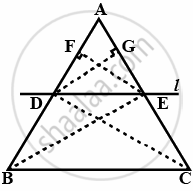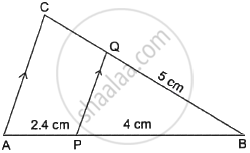Advertisements
Advertisements
प्रश्न
State and prove Basic Proportionality theorem.
उत्तर

Basic Proportionality Theorem states that, if a line is parallel to a side of a triangle which intersects the other sides into two distinct points, then the line divides those sides of the triangle in proportion.
Let ABC be the triangle.
The line 1 parallel to BC intersect AB at D and AC at E.
To prove `(AD)/(DB) = (AE)/(EC)`
Join BE, CD
Draw EF ⊥ AB, DG ⊥ CA
Since EF ⊥ AB,
EF is the height of triangles ADE and DBE
Area of ΔADE = `1/2 xx "base" xx "height"`
= `1/2 AD xx EF`
Area of ΔDBE = `1/2 xx DB xx EF`
`("Area of" ΔADE)/("Area of" ΔDBE) = (1/2 xx AD xx EF)/(1/2 xx DB xx EF) = (AD)/(DB)` ...(1)
Similarly,
`("Area of" ΔADE)/("Area of" ΔDCE) = (1/2 xx AE xx DG)/(1/2 xx EC xx DG) = (AE)/(EC)` ...(2)
But ΔDBE and ΔDCE are the same base DE and between the same parallel straight line BC and DE.
Area of ΔDBE = Area of ΔDCE ...(3)
From (1), (2) and (3), we have
`(AD)/(DB) = (AE)/(EC)`
Hence proved.
APPEARS IN
संबंधित प्रश्न
In the following figure, DE || AC and DF || AE. Prove that `("BF")/("FE") = ("BE")/("EC")`

In ΔABC, D and E are points on the sides AB and AC respectively such that DE || BC
If `"AD"/"BD"=4/5` and EC = 2.5 cm, find AE
M and N are points on the sides PQ and PR respectively of a ΔPQR. For the following case, state whether MN || QR
PM = 4cm, QM = 4.5 cm, PN = 4 cm and NR = 4.5 cm
ΔABC is am equilateral triangle of side 2a units. Find each of its altitudes.
In ΔABC, D is the midpoint of BC and AE⊥BC. If AC>AB, show that `AB^2= AD^2+1/4 BC^2 −BC.DE `
State and converse of Thale’s theorem.
Draw an isosceles triangle with base 5 cm and height 4 cm. Draw a triangle similar to the triangle drawn whose sides are `2/3` times the sides of the triangle.
A and B are respectively the points on the sides PQ and PR of a triangle PQR such that PQ = 12.5 cm, PA = 5 cm, BR = 6 cm and PB = 4 cm. Is AB || QR? Give reasons for your answer.
In figure, line segment DF intersect the side AC of a triangle ABC at the point E such that E is the mid-point of CA and ∠AEF = ∠AFE. Prove that `(BD)/(CD) = (BF)/(CE)`.
In the given figure, PQ || AC. If BP = 4 cm, AP = 2.4 cm and BQ = 5 cm, then length of BC is ______.

